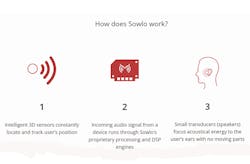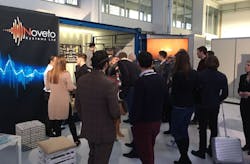When Israeli entrepreneur Tomer Shani was looking for the next big idea in 2011, he realized he should have been listening. There have been so many advances in touchscreens and other displays as they have gone from HD to 3D to 4K and now to the realm of virtual reality, but there hasn’t been any major innovation in sound technology for decades.
“There have been higher quality speakers, but no real evolution,” says Shani, a former defense contractor.
The company he co-founded and is CEO of, Noveto Systems, may have just dialed that evolution up to 11 with its virtual speaker technology, Sowlo. This sound system pinpoints a listener’s ears through 3D sensors and directs audio from a transducer right to them, with no need for earbuds or a hearing device. Noveto expects the technology to be effective in cars, the office, and even on assembly lines.
It’s all part of what Shani considers the “Internet of Sound,” a new, much more personal and discrete way of transmitting audio.
Using beamforming technology, the signal can transmit sound from 16 ft. away, even through hair, while the music or phone call you’re listening to remains discrete. The smart system even tracks movements based on the position of your face and readjusts appropriately, which allows you to move naturally as you listen.
According to the company website, “these soundwaves are for your ears only.”
Shani says someone standing two feet away would possibly detect a “murmur,” but no discernable words, so your carpool buddies will never know about your unhealthy obsession with Shania Twain (until you start singing along). This would come in handy anytime Siri is trying to give you directions to Mulberry Road while the kids are loudly listening to how to get to Sesame Street.
For assembly line workers, this personal sound system would allow you to listen to your favorite productivity-boosting music without disrupting your co-workers.
But what’s the big deal? Can’t they just put on headphones? In an industrial setting, where workers need to be in communication and be aware of their environment, headphones can be a significant safety hazard.
“You don’t want any workers to have headphones because they’d be disassociated from the environment,” Shani cautions.
Sowlo doesn’t block out important plant alarms or commands[TH1] , such as if there is a plant emergency or if a process is changing.
In its current form, one system can transmit sound to four points, or two pairs of ears. A foreman could also conceivably control the system from a tablet computer and send direct verbal instructions to one specific worker, leaving the others to their repetitive task[TH2] . For bosses, now you can praise in public and criticize in private without your subordinate ever leaving the line.
Other important factors for factory workers: it’s wireless and completely comfortable. Apple’s AirPods, released last December, seem absolutely archaic by comparison.
Sound Business Model
While the Sowlo demonstrator is about the size of a smartphone charger, at this stage, the technology is way too new to scale down into a smartphone just yet, Shani says.
The company has plans to head that way, though, as people’s use of smartphones did give Shani the idea for Solow.
“Screens are relatively private and personal, but audio goes everywhere, unless it’s a hearing device,” Shani says.
That led to his great revelation: “Audio should behave the same as the screen; it should be in the device and give you the same level of privacy.”
Shani teamed up with Noam Babayoff, a college friend from Tel Aviv University who had medical device R&D expertise, and the two set out to somehow innovate sound through their startup Noveto Systems, borrowing from the Latin for innovation (novus).
After two years prototyping in “garage mode,” Sowlo was born. An investor helped them reach the next growth stage in 2015, and last July, Noveto was entrenched in a survival-of-the-fittest competition. Facing off against 299 other would-be innovators at Daimler's Startup Autobahn Accelerator, Noveto was chosen as one of the 13 companies to present to more than 1,000 auto executives, entrepreneurs, and venture capitalists in Stuttgart, Germany.
Shani showed off how the sound system would work in a Mercedes-Benz, using hand gestures to switch the car’s audio system from the traditional speakers to the Sowlo system.
The sound system made a lot of noise at the event, and several major automakers are in talks to further develop the system, with the office as the next sector for the Internet of Sound to disrupt by not being at all disruptive.
For more information, please contact [email protected].
About the Author
John Hitch
Editor, Fleet Maintenance
John Hitch, based out of Cleveland, Ohio, is the editor of Fleet Maintenance, a B2B magazine that addresses the service needs for all commercial vehicle makes and models (Classes 1-8), ranging from shop management strategies to the latest tools to enhance uptime.
He previously wrote about equipment and fleet operations and management for FleetOwner, and prior to that, manufacturing and advanced technology for IndustryWeek and New Equipment Digest. He is an award-winning journalist and former sonar technician aboard a nuclear-powered submarine where he served honorably aboard the fast-attack submarine USS Oklahoma City (SSN-723).




